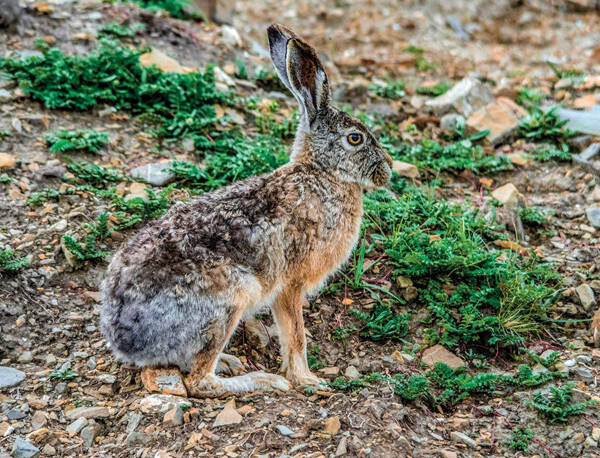Lepus tolai
IUCN
LCBasic Information
Scientific classification
- name:Lepus tolai
- Scientific Name:Lepus tolai,Hare, Central Asian rabbit, Steppe rabbit
- Outline:Lagoiformes
- Family:Lagomorpha Leporidae Lepus
Vital signs
- length:400-550mm
- Weight:1500-2500g
- lifetime:
Feature
There is a long and wide black spot in the center of the back of the tail, and the edges and the ventral side of the tail are pure white, extending to the base of the tail.
Distribution and Habitat
It is widely distributed in China, and is found in all provinces in the central and eastern regions, including Sichuan, Chongqing, Shaanxi, Shanxi, Guizhou, Gansu, Hubei, Qinghai, the three northeastern provinces, and provinces in North China. It is also found abroad in Iran, Afghanistan, Turkmenistan, Uzbekistan, Kazakhstan, Russia, and Mongolia.
Mongolian rabbits are mainly found in grass, shrubs, farmland, and forest edges.
Appearance
The Mongolian rabbit is of medium size in the genus Lepus. The tail is long, reaching about 80% of the length of the hind leg, and it is the longest tail of the Chinese wild rabbit. The ears are short, only 83% of the length of the hind leg. The overall color is straw yellow, but the fur color of individuals in different regions varies. The hip spot is grayish white or light yellow. There is a long and wide black or brownish black stripe in the center of the back of the tail, and the sides and the belly are white. The belly of the body is white. The tip of the ear is black. On the skull, the snout is thick and short.
Details
Mongolian rabbits are active both day and night, but are most active at dusk. The number of Mongolian rabbits is relatively small. In the plains, Mongolian rabbits mostly live in semi-desert and desert steppes, oases, or Artemisia grass steppes with halophytes, and in the woods, canal banks, fallow land, etc. in the oasis.
In mountain valleys, they mostly live in swamp meadows, reed lakes, and river-flooded shrubs.
In the mountains, they mostly live in shrubs and woods. They are diurnal, mostly active at dusk before sunset and in the early morning when the sun rises. They have no fixed caves, and mostly build semi-open shallow caves in the bushes to live in. In mountainous areas where marmots are distributed, they often appear in marmot caves.
The main external flea parasite of Mongolian rabbits is the ice flea. In the habitat of gerbils, the breech flea, the tufted bristle flea, the rough bristle flea, the homotypic flea and the bald disease flea can be found. In the Junggar Desert, the red rhipicephalus, the short rhipicephalus and the punctate blood tick have been found on the body.

Mongolian rabbits eat plant-based food, and there are many types: grass, seedlings, twigs, bark, and various crops, vegetables and seeds can serve as their food. In addition to pea leaves in spring, they also eat a lot of wheat seedlings, but most of these wheat seedlings grow in areas with less nitrogen fertilizer; in early summer, they eat the soft and tender parts of large and small wheat violets, and after transplanting rice, they mainly eat various bean leaves; in late autumn, they often forage for lost seeds, fallen leaves, weeds and grass in the fields; after the autumn harvest, they eat a lot of wheat seedlings. In late winter, when food in the fields is scarce, they often scrape garbage dumps near villages to find food, and also steal forage grass. When snow accumulates, they also dig through the snow to look for wheat seedlings and other food.

The Mongolian rabbit is widely distributed and has a large output. It is an important fur animal in North China, and its output in other regions is also very high. After its skin is gently kneaded, it is dyed into various pseudo-skins. Among the furs, winter fur is the best.

Medicinal Uses of Mongolian Rabbits
Meat: Treats loss of appetite, shortness of breath and spontaneous sweating caused by weak spleen and stomach.
Blood: Cools blood, stops bleeding, relieves heat and toxins in the fetus, and induces labor, and treats heart and qi pain.
Bone: Treats thirst, dizziness, scabies and other diseases.
Liver: Nourishes the liver and improves eyesight, clears the liver and relieves pain, treats night blindness, blurred vision and liver deficiency dizziness.
Listed in the "World Conservation Union" (IUCN) ver 3.1: 2008 Red List of Mammalia, Leporidae - Low Risk (LC).







